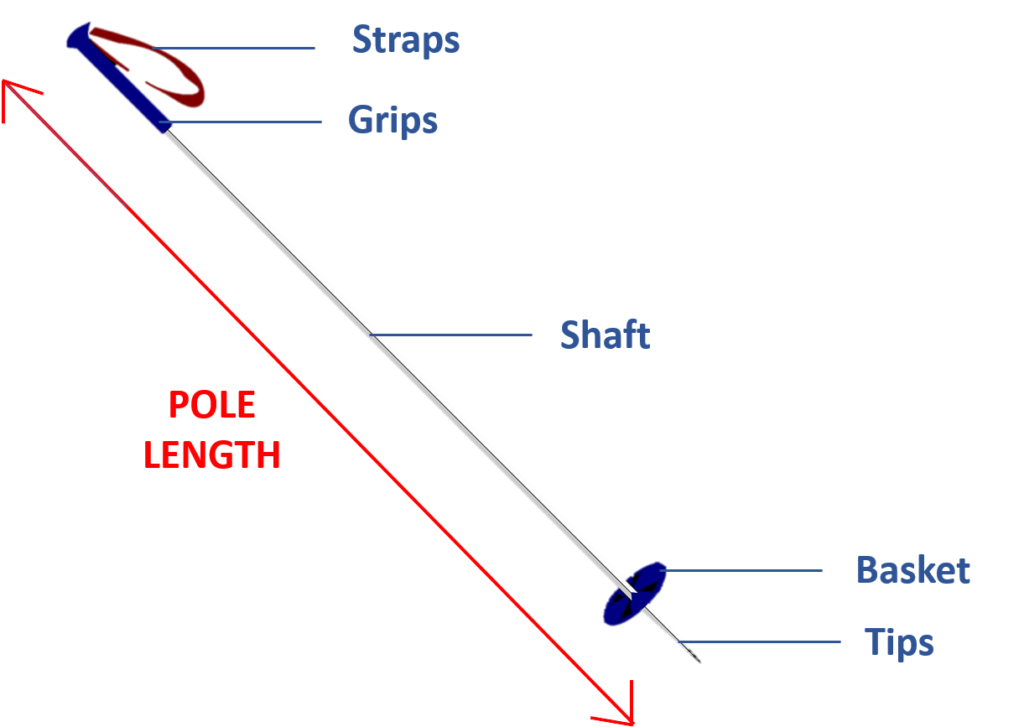Whether you are planning your first ski trip or are just looking to buy your first set of ski gear, understanding the type of gear you need is important. Many people think initially about skis and boots, but your ski poles are also a very important piece of kit to get right!
One of the most important features about your poles is their length and you may see lots of different lengths of poles wherever you look.
But it is important to know exactly what is meant by ski pole length and how this is measured. So, what are the parts of a ski pole and how exactly is ski pole length measured? Keep reading for everything you need to know!
You might also want to know what ski pole length is right for you and how best to determine this. While it is important to test this out in person if possible and at many ski shops, you will be helped to measure the right length for you against you height, but it is always good to have an idea of the estimated length you’re looking for.
At a Glance
Ski pole length can be measured from the end of the grip to the tip of the pole. The pole length you need depends on your height and type of skiing you will be doing.
Why is Ski Pole Length Important?
Ski poles can be an extremely useful piece of kit which can be used to help to push you along on flatter areas or to help with your turning on more difficult slopes through certain techniques.
Ski pole length is determined mostly by your height because the right length will mean you are comfortable using them and not having to stoop down for example with poles that are too short. This will affect not only your comfort while skiing but also your technique and ability to keep improving.
Ski pole length can also affect your abilities to effectively use different techniques. For example, more advanced skiers may want slightly shorter poles if they will tend to bend their legs more than less advanced skiers when travelling faster or making sharper turns.
Parts of a Ski Pole

Straps–
These are the fabric loops normally attached to the handle of your poles. Lots of people choose to use these to help them not to lose their poles and these are normally adjustable in their length.
Grips–
This is where you’ll normally hold onto your poles. These are normally designed to be large enough to hold with your ski gloves but can vary in their shape. It is always good to try these out while wearing your ski gloves to check that the grip is the most comfortable for you!
Some grips will be larger at the top to help you to effectively hold the poles without your hand shifting too much, making sure you keep hold of them while skiing or getting on and off ski lifts.
For different purposes, the size and shape of your ski pole grip could change. For example, for racing, some skiers have a protective shield extending from the grips to help to protect their hands from hitting the gates.
For cross country skiing, grips may be longer so you can hold the pole lower down at certain points if you need to. Whatever style of skiing you are planning to do, finding grips that are comfortable is essential to making the most of your ski trip!
Shaft–
The shaft constitutes the main part of your poles and are mainly responsible for their length and weight. The shafts for many skiers will be straight, but poles designed for downhill skiing and racing may be curved to help them to be the most aerodynamic and curve around the skiers body.
The shafts of your ski poles can also be made from different materials with different properties. For example, aluminium shafts can be stronger and more resistant to changing their shape with impact compared to carbon fiber shafts.
However, carbon fiber shafts are also easier to bend back into place. Regardless of the material, if the shaft of your ski poles undergoes too many impacts, it could bend out of shape or even break completely.
Basket–
The basket is normally the widest part of your poles situated just above the tips and near the bottom of the shafts the poles. The baskets can change in shape and size depending on the brand or style of skiing they are designed for, but are usually disk-shaped.
For poles designed for power snow, the baskets may need to be larger in diameter to create the largest surface area. This will help to resist the pole sinking too deep into the soft snow, meaning you can effectively push against the powder. Racing poles may have very small baskets to make them more aerodynamic.
Tips–
The tips are the pointed section below the baskets at the very bottom of your ski poles. This is the part which digs into the snow up to the point of the baskets.
They will normally be slightly pointed to make sure they can effectively dig into the hard snow or ice and are usually made out of plastic with metal tips, although there are some differences between brands and styles.
Cheaper poles for beginner skiers may simply have tips which are a continuum of the shaft, whereas more expensive poles for experienced skiers may even have replaceable tips.
How to Measure Ski Pole Length
Ski pole length is usually measured in inches or centimetres, from the very tip of the pole to the end of the grip. Poles usually increase in 5 cm increments, although this may not always be the same with different brands and makes.
However, when testing ski poles, is it good to remember that when using your poles you will be in ski boots and on skis which will make you slightly taller. The tip of the poles is also likely to dig into the snow, possibly up to the point of the baskets, making the poles feel even shorter when you are using them.
Ski Pole Length and Height
Height is used to help determine what length of ski pole each individual skier needs. This means that you will be most comfortable when holding your poles and skiing, however some skiers might have a preference for longer or shorter poles so it is important to test these out and see which poles suit you best!
In general, many skiers use the rule that with their ski boots on, their arms are at about a 90 degree angle when holding their poles with their arms at their sides. This will be determined partially by your height, as taller people will likely require longer poles.
Adjustable Ski Poles
Some ski poles have the function of being adjustable in length. While these will still have limits to the shortest and longest length the pole can reach, adjustable poles can be incredibly useful if you are planning on dramatically changing your skiing style, or want to test out different lengths to see which suits you best.
Conclusion
To conclude, ski pole length is generally measured from the end of the tip to the very top of the grip of your ski poles. The right ski pole length for you can be determined by your height and type of skiing you are looking to do.
Here are some more articles you might find useful:
